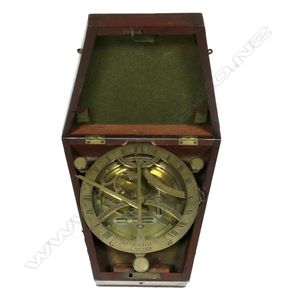Antique Brass Sundial with Box and Provenance
An early 19th century brass universal equinoctial sundial, marked to the 6 inch ring 'Jacob & Halse, London', (specialist scientific instrument dealers, active 1808-1823), with sprung hinged gnomon and arc, glazed conforming circular base with three milled screw adjusters, the well with engraved compass rose and set with two bubble levels framed by an engraved bevel in 90º quadrants. In fitted keystone mahogany box. Provenance: The H.N.E Sheppard Estate Collection.
You must be a subscriber, and be logged in to view price and dealer details.
Subscribe Now to view actual auction price for this item
When you subscribe, you have the option of setting the currency in which to display prices to $Au, $US, $NZ or Stg.
This item has been sold, and the description, image and price are for reference purposes only.
- Mahogany - Mahogany is a dense, close grained red-coloured timber from the West Indies and Central America. It was first imported into Europe in the the early 18th century and its use continued through the 19th century. It was popular for furniture making because of its strength, the wide boards available, the distinctive grain on some boards, termed flame mahogany and the rich warm colour of the timber when it was polished.. The "flame" was produced where a limb grew out from the trunk of the tree, and this timber was usually sliced into veneers for feature panels on doors, backs and cornices.
Some terms used to describe mahogany relate to the country from which it originally came, such as "Cuban" mahogany, "Honduras" mahogany etc. However unless the wood has been tested the names assigned are more a selling feature, rather than a true indication of the timber's origin. - Equinoctial Dial on a Sundial - An equinoctial dial is a type of sundial that uses the equator as a reference plane and the gnomon, or sundial arm, is positioned perpendicular to the equator, which allows the sundial to be used in any location with a clear view of the sun and provides an accurate reading of local solar time.
Equinoctial dials were first developed in ancient Greece and were later refined by Arab astronomers. The dials became popular in Europe during the Renaissance, when they were used as both scientific instruments and works of art. Equinoctial dials were particularly popular in Italy, where they were often made of bronze or stone and were decorated with intricate engravings, sculptures, and inscriptions. The sundial as an instrument was superseded by the chronometer. - Bevel / Chamfer - In furniture making, a chamfered corner refers to a technique used to create a smooth, angled edge on the corner of a piece of furniture. This is typically done by cutting away a small portion of the corner at an angle, typically 45 degrees, creating a diagonal edge, rather than a sharp 90-degree angle. This technique can be used on various parts of a piece of furniture such as table legs, drawer fronts, or door frames. Chamfering can add visual interest to a piece and can help to soften the overall look of a piece of furniture. It is often used in conjunction with other techniques, such as rounding edges or using contrasting wood species to create a more elegant, sophisticated look. Chamfering is a simple way to add a touch of elegance to a piece of furniture and it is a common technique used by furniture makers.
This item has been included into following indexes:
- sundials
